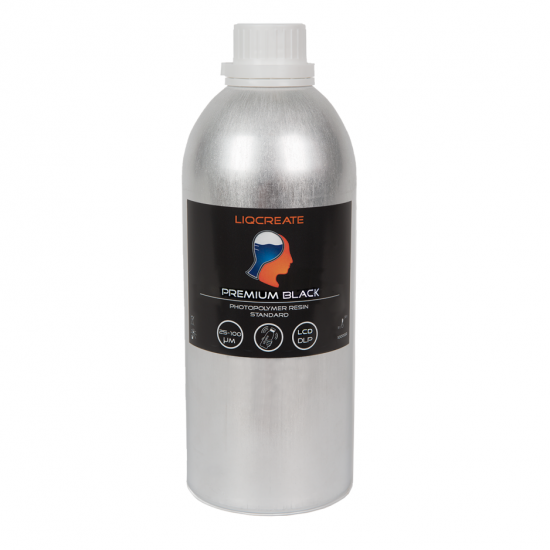When we optimize resins or print test parts, we usually use models that are at least a few millimeters thick and do not have thin load-bearing structures. For most Liqcreate resins it is easy to print small details. However, to print very fine parts (miniature wheel) without much support to the model, that is different. So when one of our partners asked about an application in small model wheels with extreme thin spokes, we did not have the answer ready and decided to test it together in a few resins: Liqcreate Flame Retardant HDT, Liqcreate Strong-X, Liqcreate Composite-X and Liqcreate Premium Black. The first four resins were chosen as we expect that rigid materials might be best for this task. Premium Black resin was added as a rigid option with faster print speed and the black color could help with the green strength due to more extensive energy build-up in the layer.
Tested resins and their rigidity – higher modulus means more rigid material
| Resin | Modulus |
| Premium Black | 1.8 GPa |
| Strong-X | 3.4 GPa |
| Flame Retardant HDT | 4.4 GPa |
| Composite-X | 9.0 GPa |
A few test STL files were prepared by our partner. Four model wheels with spokes diameters 0,30mm – 0,25mm – 0,20mm and 0,145mm and a block with holes of 1 – 2 – 5 – 10 – 20 mm diameter to check the amount of bleeding when increasing the exposure time or changed the settings.
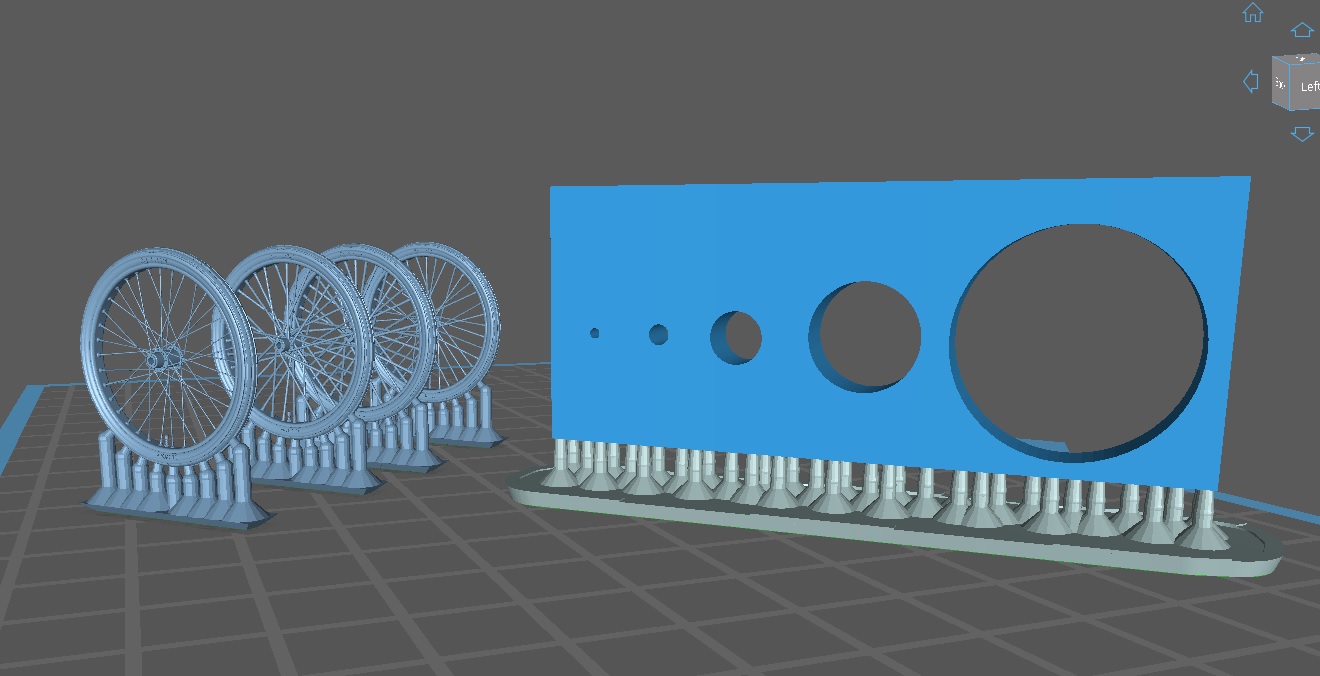
All resins were tested on the new Elegoo Saturn 3 printer at 0,1mm layer thickness. A variation in exposure time and in a few cases the print speed was modified as our engineers expected these two are the main factors next to the resin and hardware.
Strong-X: printing thin model wheels with thin spokes
In the picture below you can find the results. On the rows from top to bottom you can find the exposure time of 8 seconds on top, 12 seconds middle and 16 seconds bottom. Initially 8 seconds was our default but now we increased it to 10 seconds exposure time for 0,1mm layers. Only from the bottom line – 16 seconds exposure time – the two thickest spokes of 0,30mm and 0,25mm were printed fine. But the good thing is that there is minimal through-cure / bleeding in the other parts. increasing the exposure time even further did not seem like a viable option, let’s try a different resin.
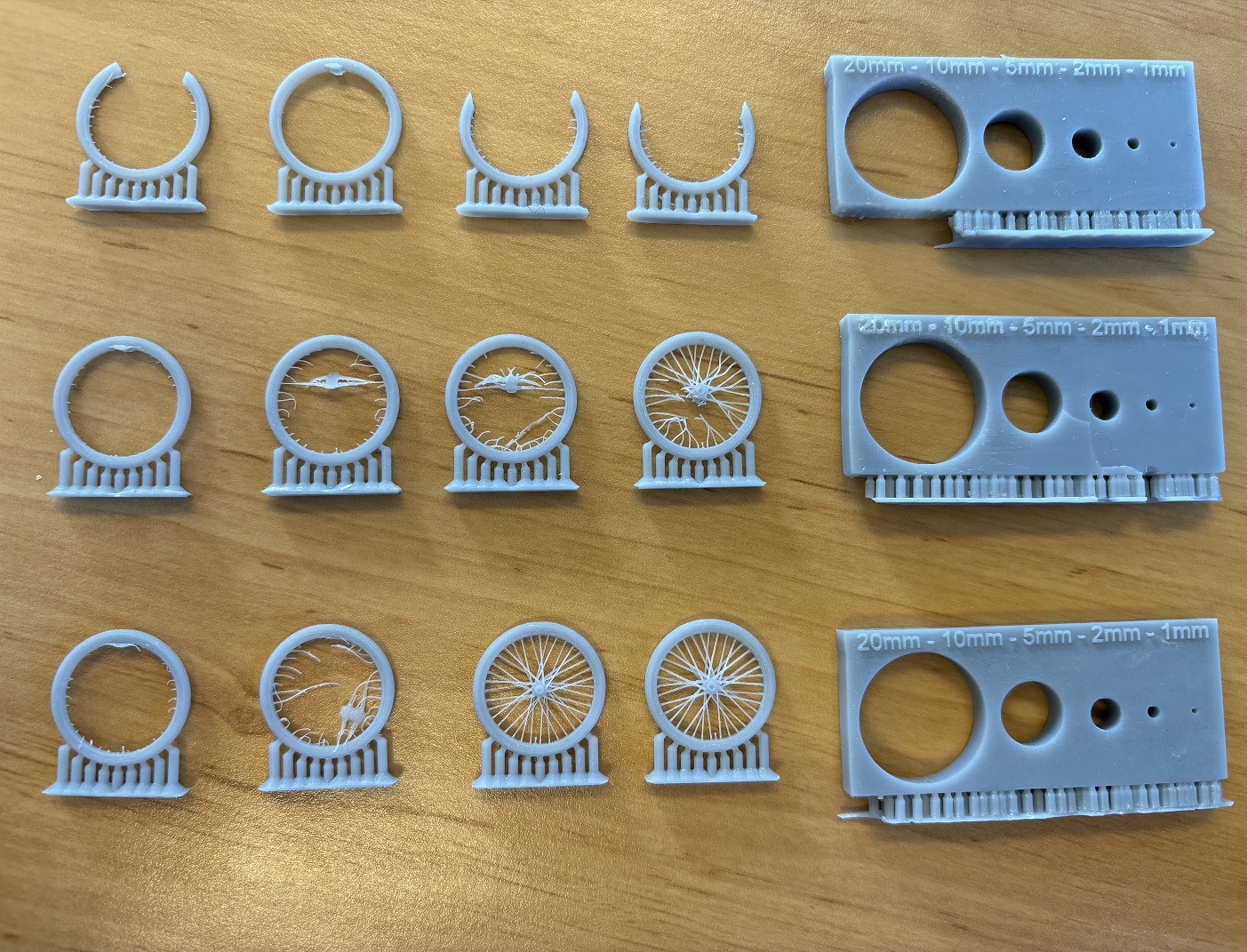 To give a bit better idea how the model looks like that we are printing, here is a close-up of the wheel that was printed successful:
To give a bit better idea how the model looks like that we are printing, here is a close-up of the wheel that was printed successful:
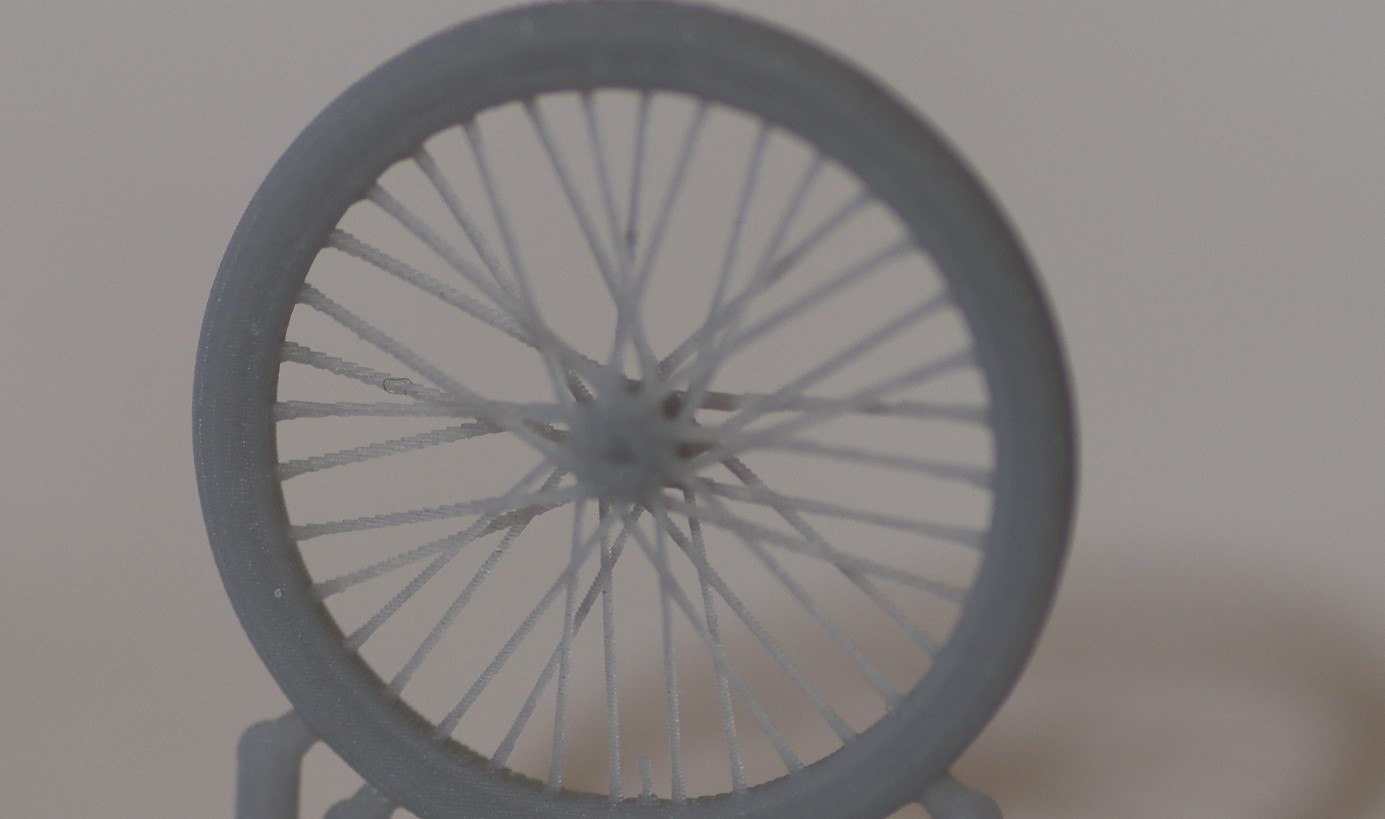 As you can see on the left side of the wheel, all nearly horizontal spokes have an extreme over-hang. Next to their challenging size, printing without supports requires a lot from the resin.
As you can see on the left side of the wheel, all nearly horizontal spokes have an extreme over-hang. Next to their challenging size, printing without supports requires a lot from the resin.
Premium Black: printing thin model wheels with spokes
The results can found below in a similar representation as Strong-X. On the top row there is the standard 4,4 seconds exposure time, followed by: 7,5 seconds , 9,5 seconds, 12 seconds and 20 seconds. With this resin the basic settings already yielded an acceptable wheel printed with 0,30mm spokes. While at 7,5 seconds the one with a diameter of 0,25mm came out fine and after 9,5 seconds even the third wheel with spokes of 0,20mm were printed well. Although not completely stable at 9,5 seconds, with 12 seconds it was much better and the through-cure / bleeding was minimal. That setting is therefore the best we found. With 20 seconds the last wheel was still not printed, while bleeding / through cure effects started to become visible.
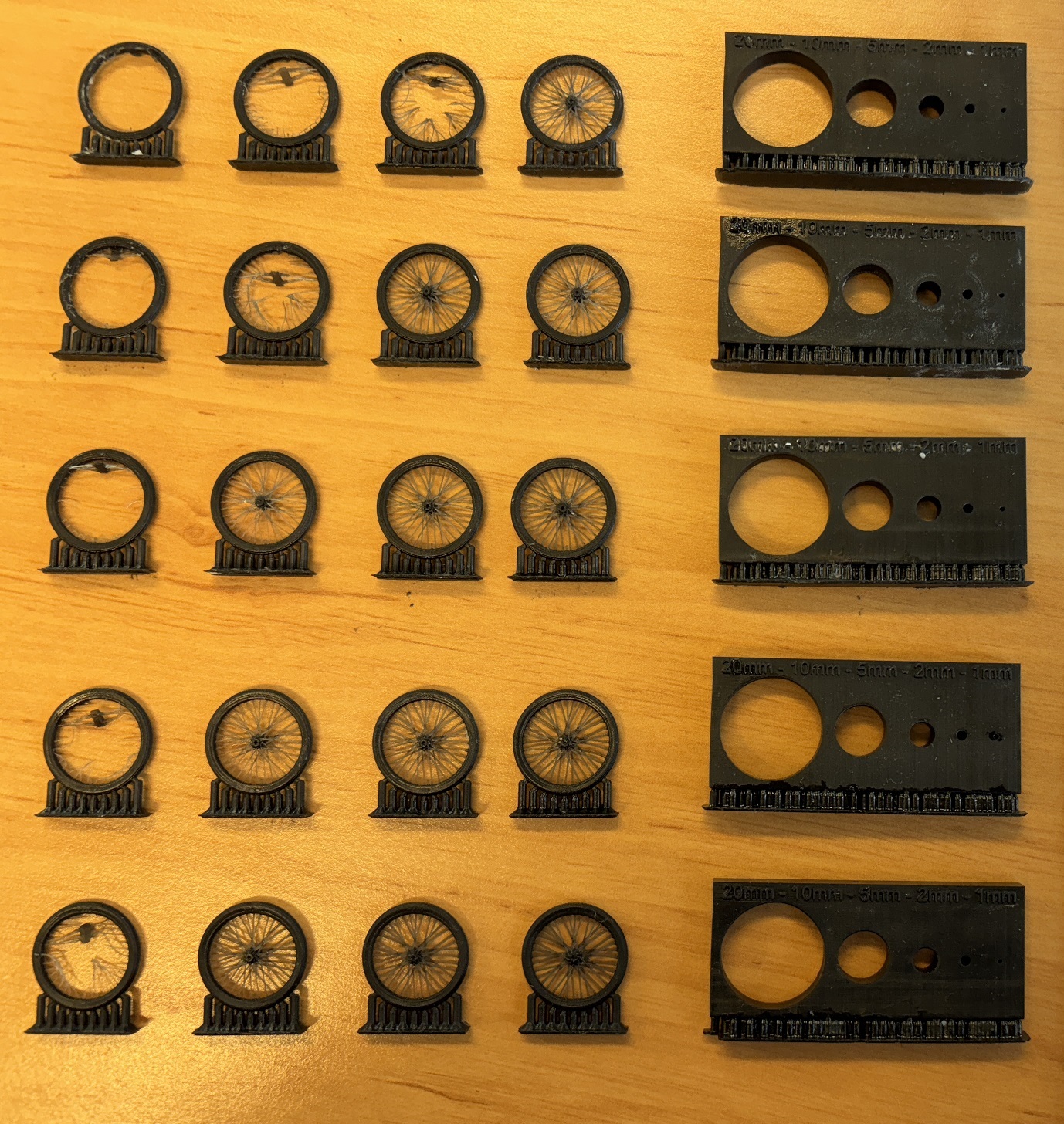 To get a bit better view of the best one at 12 seconds, here is a close-up:
To get a bit better view of the best one at 12 seconds, here is a close-up:
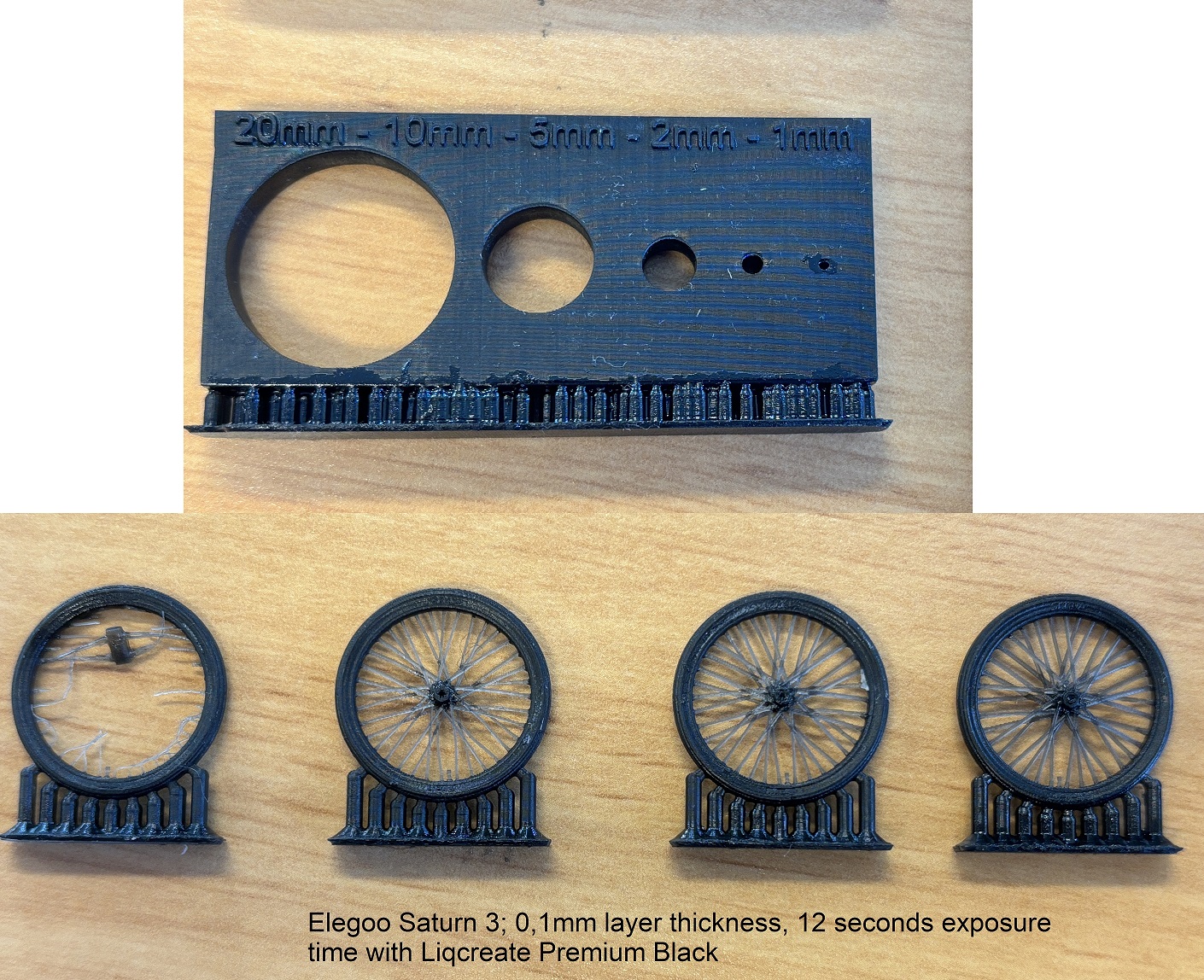 Next to the regular speed settings which were used for all the prints above, we also tested slower settings. The theory is that if you increase the waiting time and decrease the lift speed, a stronger layer is formed and it is easier to print these very fine features.
Next to the regular speed settings which were used for all the prints above, we also tested slower settings. The theory is that if you increase the waiting time and decrease the lift speed, a stronger layer is formed and it is easier to print these very fine features.
On the left you can find the slower print were the waiting time was increased and the lift speed was decreased. Leading to a 3x longer print. Unfortunately there is not much difference with the reference model on the right side.
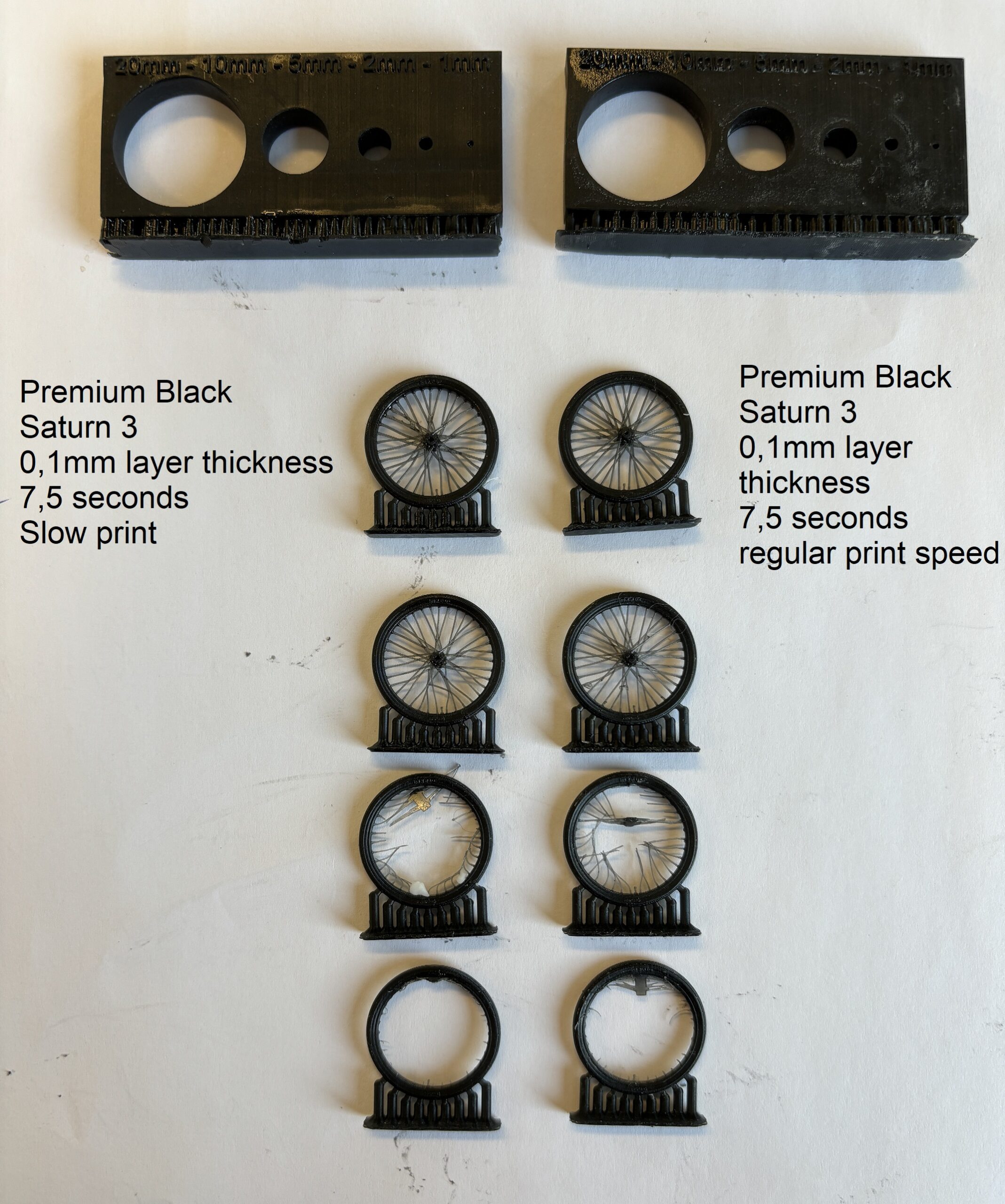
Flame Retardant HDT resin & Printing fine details
Next in the test is Liqcreate Flame Retardant HDT. With its fairly high modulus of 4.4 GPa it is a rigid material. Similar test as before with exposure times from top to bottom row of: 5,5 seconds – 6,5 seconds – 8,0 seconds – 10,0 seconds and 12,0 seconds.
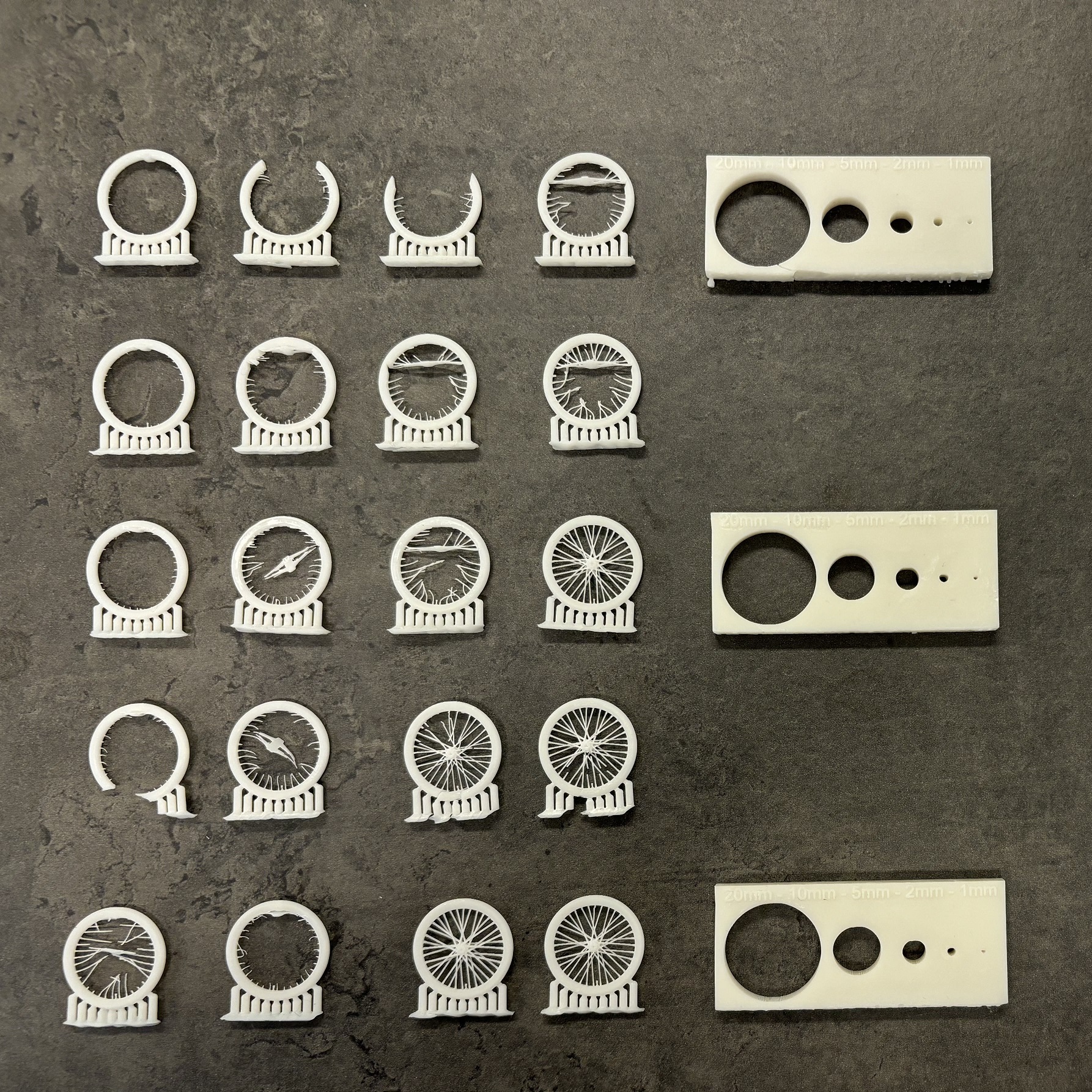 Increasing the exposure time to 8,0 seconds yields the first successfully printed 0,30mm spoke, with the downside a slight through-cure. You can see the block in the right middle that the round holes are starting to get a bit flat on the top. Increasing to 10 and 12 seconds exposure time is enough to print the 2nd spoke with diameter of 0,25mm, with similar bleeding. Concluded that this might not be the best resin for the task as you will lose some accuracy when increasing the exposure time to print thin parts.
Increasing the exposure time to 8,0 seconds yields the first successfully printed 0,30mm spoke, with the downside a slight through-cure. You can see the block in the right middle that the round holes are starting to get a bit flat on the top. Increasing to 10 and 12 seconds exposure time is enough to print the 2nd spoke with diameter of 0,25mm, with similar bleeding. Concluded that this might not be the best resin for the task as you will lose some accuracy when increasing the exposure time to print thin parts.
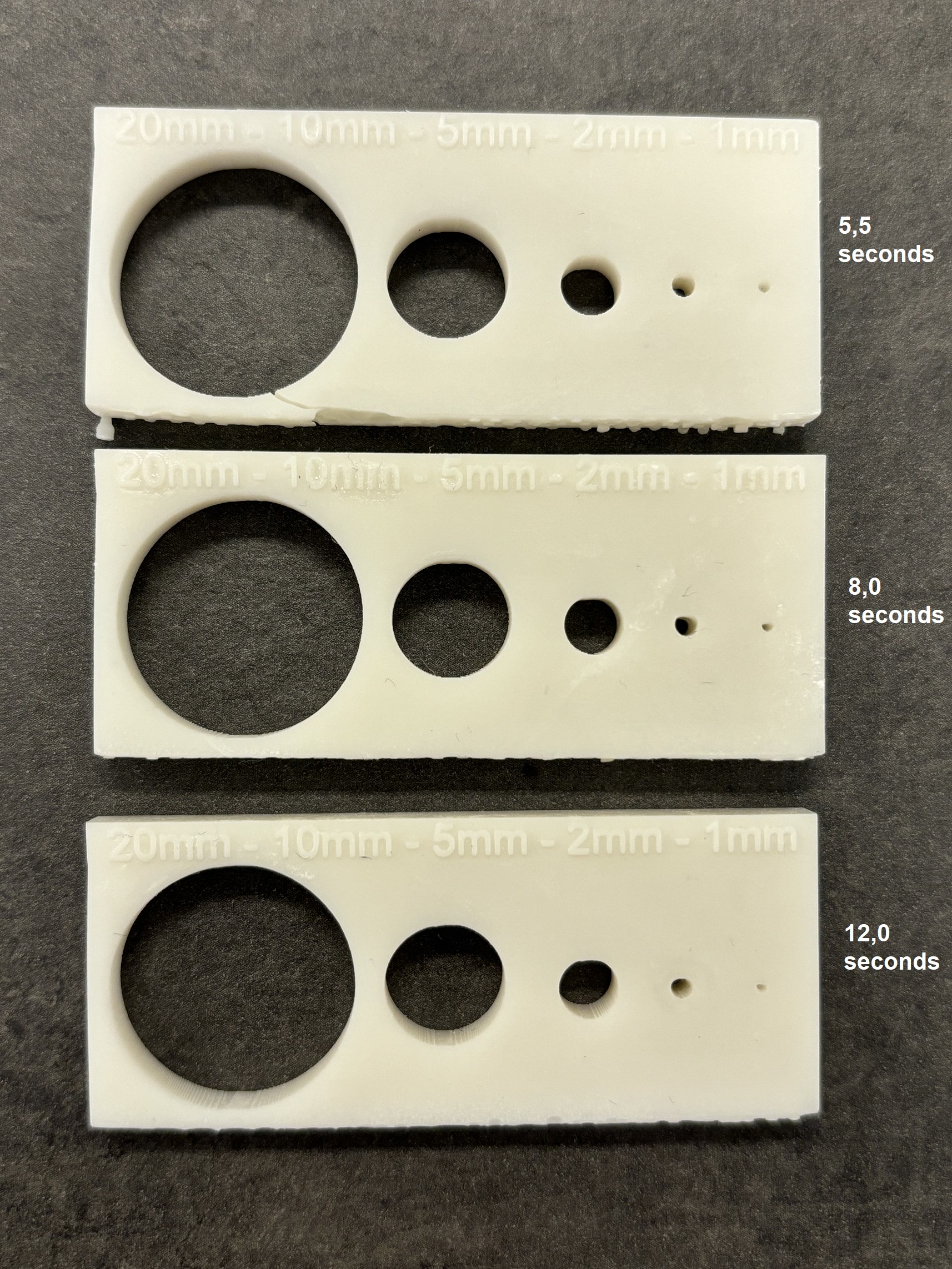
Composite-X extremely rigid for printing fine structures?
Well, last one in the test and the one we would expect to perform best due to its extreme rigid nature. Similar compared to Premium black, in the top row (12 seconds exposure) the two thin spokes were completely formed. Addition of 3 seconds exposure to 15 seconds yielded another wheel that was printed completely. Further increase to 20 seconds did not do much.
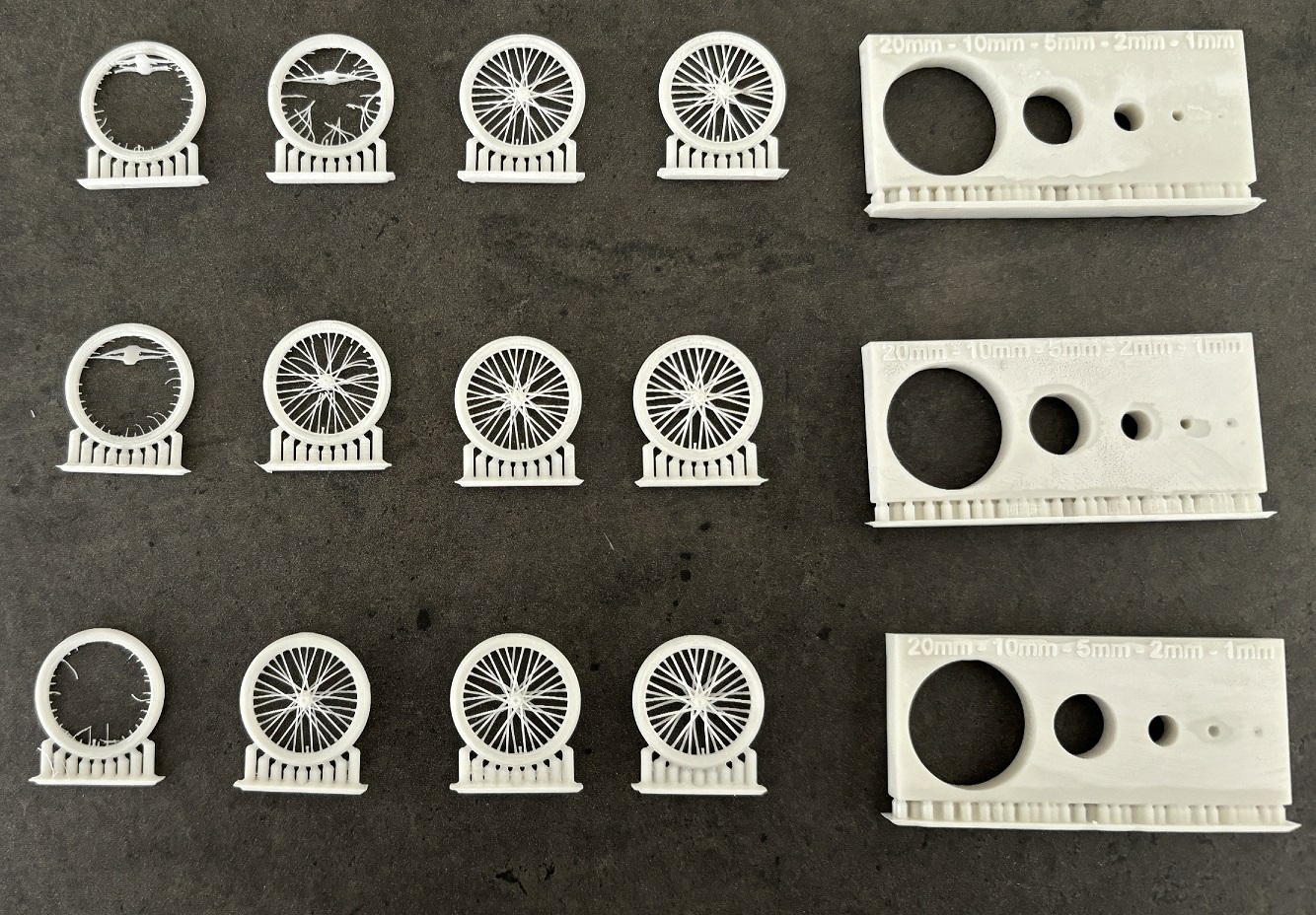
Conclusion:
Not necessarily the most rigid materials performed best. Both Premium Black and Composite-X yielded similar results. As Premium Black is easier to process, we would advise to choose this resin for these type of applications.
Support
Do you need any help with 3D printing our SLA, DLP or LCD resins? We can help you! Just look for the question you have below. If you can’t find it, let us know by contacting us!
Printer Settings →
find 3D-printing resin for accurate, detailed and tiny miniature 3D-printing parts
Premium Black
Liqcreate Premium Black is an opaque black photopolymer resin with excellent color stability, ideal for rapid prototyping and concept product development. 3D-printed parts from this material have exceptional dimensional stability and low shrinkage during printing. Liqcreate Premium Black is easy to use on all open source MSLA/LCD and DLP 3D-printers in the range of 385 – 420nm. This material has excellent properties like low shrinkage and low odor, which makes it ideal for applications that require an opaque, deep black surface finish.
Key benefits
|
3D-Printer compatibility |
| · Opaque Black | · Asiga Max & Pro 4K |
| · Compatible with 2K, 4K & 8K printers | · Shininig3D Accufab-L4K |
| · Low odor | · Elegoo & Creality Series |
| · Low shrinkage | · Anycubic & Phrozen Series |
| · High reactivity | · And many more |
